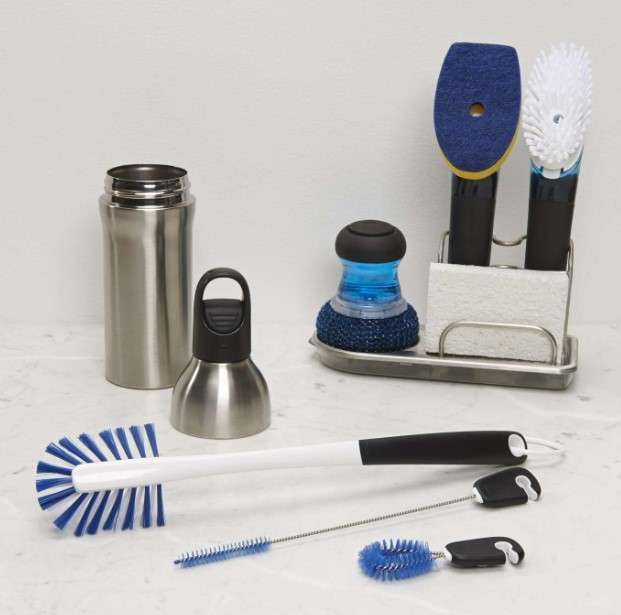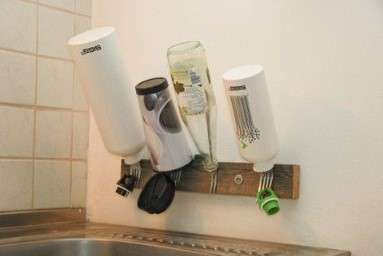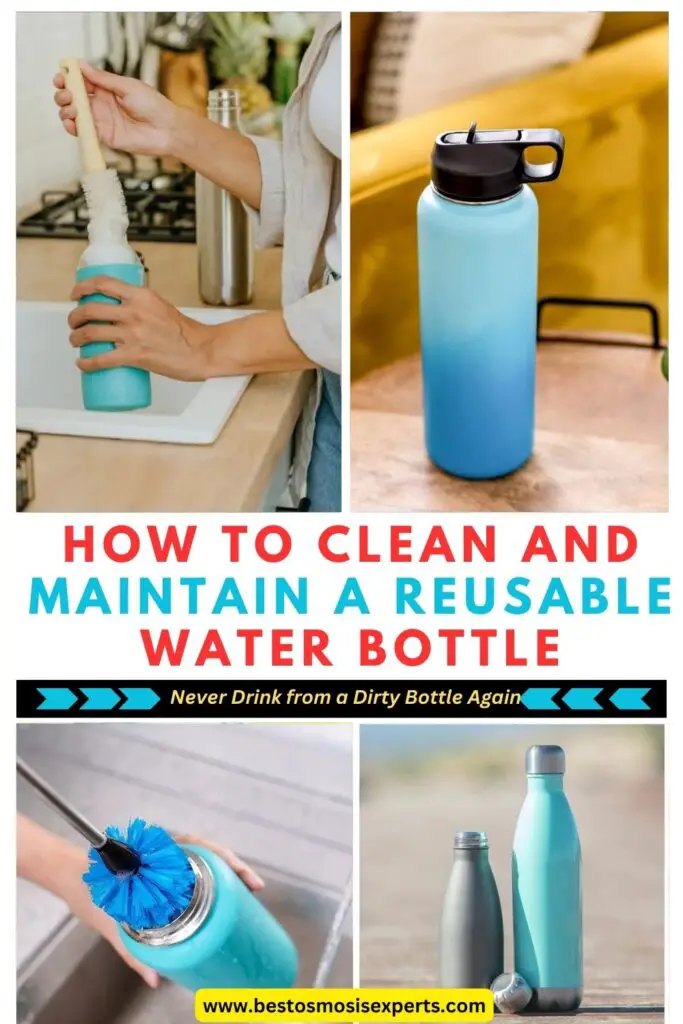Bottle water has become an indispensable companion in our daily lives, offering hydration on-the-go while reducing plastic waste. Yet, as we continuously refill and reuse these vessels, it’s crucial to ensure they remain clean and well-maintained.
Neglecting this aspect can lead to bacterial growth and unpleasant odors, compromising both taste and health. In this guide, we’ll delve into the importance of cleaning and maintaining reusable water bottles, providing you with simple yet effective strategies to keep them pristine.
From basic cleaning techniques to advanced care tips, discover how to extend the lifespan of your bottle water while safeguarding your health. Read on to find out more and ensure your hydration companion stays fresh and reliable.
How to Clean a Reusable Water Bottle

Cleaning your reusable water bottle is important to keep it free of bacteria and other harmful microorganisms. Here are a few tips on how to clean your water bottle:
- Use a mild detergent and warm water. This is the most basic way to clean your water bottle. Simply fill the bottle with warm water and a few drops of mild detergent, then shake it well. Rinse the bottle thoroughly with warm water.
- Use a bottle brush. A bottle brush can help you reach into the nooks and crannies of your water bottle to remove dirt and grime. Be sure to clean the brush thoroughly after each use.
- Soak your water bottle in a vinegar solution. Vinegar is a natural disinfectant that can help to kill bacteria and other microorganisms. To soak your water bottle in a vinegar solution, fill the bottle with equal parts vinegar and water. Let the bottle soak for at least 30 minutes, then rinse it thoroughly with warm water.
- Use a baking soda solution. Baking soda is another natural disinfectant that can help to clean your water bottle. To use a baking soda solution, fill the bottle with equal parts baking soda and water. Let the bottle soak for at least 30 minutes, then rinse it thoroughly with warm water.
- Use a hydrogen peroxide solution. Hydrogen peroxide is a powerful disinfectant that can help to kill bacteria and other microorganisms. To use a hydrogen peroxide solution, fill the bottle with equal parts hydrogen peroxide and water. Let the bottle soak for at least 30 minutes, then rinse it thoroughly with warm water.
- Use a dishwasher. If you have a dishwasher, you can use it to clean your water bottle. Be sure to place the bottle on the top rack and use a gentle cycle.
Proper Cleaning Equipment and Supplies

1. Bottle brushes and cleaning tools
To maintain your reusable water bottle’s cleanliness, invest in a bottle brush or cleaning tools designed specifically for this purpose. These tools can access hard-to-reach areas and ensure a thorough cleaning.
2. Natural cleaning agents vs. commercial cleaners
While commercial cleaning agents can be effective, opting for natural alternatives is an eco-friendly choice. Lemon juice, baking soda, and vinegar can work wonders in removing stains and odors, without the worry of harsh chemicals.
3. Essential oils for extra freshness
Adding a few drops of essential oils, such as tea tree or lemon, not only imparts a pleasant aroma but also offers natural antibacterial and antifungal properties, further enhancing the cleanliness of your water bottle.
Recommended Article:- 5 Water Bottle for School Backpack
1. Daily Cleaning Routine
Handwashing vs. dishwasher: Which is better?
For many reusable water bottles, handwashing is the safest and most effective method of cleaning. Check the manufacturer’s guidelines to determine if your bottle is dishwasher-safe. However, to ensure the longevity of your bottle’s design and insulation, handwashing is often the preferred option.
How to disassemble bottle components for thorough cleaning
Some water bottles come with multiple components, such as caps and straws. Disassembling these parts before cleaning ensures that every nook and cranny is properly reached and sanitized.
Ensuring proper sanitation
Use warm, soapy water and your bottle brush to clean the interior of the bottle thoroughly. Pay extra attention to the mouthpiece and threads where bacteria can accumulate. Rinse the bottle thoroughly to remove any soap residue before use.
2. Tackling Stubborn Stains and Odors
1. Dealing with discoloration and residue
Occasionally, stains and residue may develop inside the bottle, particularly if it’s used for beverages like tea or coffee. Mixing baking soda and warm water to create a paste can help scrub away these stubborn stains.
2. Removing persistent odors effectively
Unpleasant odors can linger in a water bottle, especially if it has been left with liquid inside for an extended period. A mixture of vinegar and water can effectively neutralize odors when left to soak in the bottle for a few hours.
3. The power of baking soda and vinegar
Combining baking soda and vinegar can create a powerful fizzing action that helps dislodge tough stains and odors. This natural cleaning hack can be a game-changer in maintaining a fresh-smelling bottle.
3. Deep Cleaning Techniques
Introducing the power of sterilization
Periodically, it’s essential to sterilize your water bottle to eliminate harmful bacteria and germs. Boiling water and a thorough rinse can achieve this effectively.
Boiling water method for certain materials
For bottles made of stainless steel or glass, boiling water can be used to sterilize the entire bottle. However, it’s essential to check the manufacturer’s guidelines, as some materials may not be suitable for this method.
Incorporating specialized cleaning tablets
Several brands offer specialized cleaning tablets that are designed to target bacteria and odors effectively. These tablets are a convenient solution for maintaining a hygienic water bottle, especially during travel or when regular cleaning is not feasible.
4. Drying and Storing Your Water Bottle

The importance of complete drying
After cleaning, ensure that your water bottle is thoroughly dried before storing or using it again. Any lingering moisture can create an environment for mold and bacteria to thrive.
Using drying racks or air drying methods
Allow your water bottle to air dry on a dish rack or use specialized drying racks designed to keep the bottle and its components upright, promoting proper air circulation.
Proper storage to prevent contamination
When not in use, store your water bottle with the cap off to allow for ventilation and prevent any potential build-up of unpleasant smells.
5. Regular Maintenance and Inspection
Inspecting for wear and tear
Regularly inspect your water bottle for signs of wear and tear, such as scratches, dents, or compromised seals. Replace the bottle if any structural issues are found to maintain its integrity.
When to replace bottle components
Certain components of a water bottle, like the mouthpiece or the sealing ring, may need replacement over time due to wear or damage. Always ensure you use genuine replacement parts to maintain the bottle’s quality and functionality.
Extending the lifespan of your bottle
Proper cleaning, regular maintenance, and careful use can significantly extend the lifespan of your reusable water bottle, reducing waste and promoting sustainable practices.
6. Traveling with Your Reusable Water Bottle
Tips for on-the-go cleaning
When traveling, finding the time and resources to clean your water bottle might be challenging. Carry a small supply of biodegradable soap or cleaning wipes to ensure you can keep your bottle clean even on the move.
Avoiding leakage during travel
Choose a water bottle with a secure and leak-proof lid, especially when traveling with it in your bag or luggage. This prevents any accidental spills and keeps your belongings safe.
Staying eco-conscious while away from home
While traveling, make a conscious effort to continue your eco-friendly practices. Refrain from purchasing single-use plastic bottles and seek out water refilling stations or use water purification methods to stay hydrated sustainably.
7. Avoiding Common Mistakes
The dangers of using harsh chemicals
Avoid using harsh chemicals or abrasive scrubbers to clean your water bottle, as they can damage the bottle’s surface and potentially leave harmful residues.
Not overlooking hidden crevices
During cleaning, pay attention to the hidden crevices and seams where bacteria can accumulate. Regularly inspect and clean these areas to maintain optimal hygiene.
Skipping regular cleaning routines
Establish a consistent cleaning routine to prevent the buildup of bacteria and unpleasant odors. Skipping regular cleaning can compromise the quality and safety of your reusable water bottle.
8. Eco-Friendly Bottle Accessories
Exploring eco-conscious lids and caps
Consider upgrading to eco-friendly lids and caps made from sustainable materials like bamboo or silicone. These accessories are not only environmentally friendly but also add a unique touch to your water bottle.
Adding silicone sleeves for extra protection
Silicone sleeves offer additional protection to your water bottle, reducing the risk of breakage and providing an easy-to-grip surface. They also come in various colors and designs, allowing you to personalize your bottle.
Personalizing with sustainable engravings
Many manufacturers offer custom engraving options for water bottles. Opt for sustainable engravings, such as laser etching, to add a personal touch without using harmful chemicals or materials.
9. The Dos and Don’ts of Reusable Water Bottles
Using your bottle for intended purposes only
While reusable water bottles are versatile, avoid using them for beverages other than water unless they are explicitly designed for that purpose. Different liquids may interact with the bottle’s material, compromising its quality and safety.
Avoiding microwaving or freezing with certain materials
Certain materials, such as stainless steel or glass, are not suitable for microwave use. Similarly, freezing beverages in these bottles can cause the material to crack. Always check the manufacturer’s guidelines before attempting such practices.
Being cautious with hot beverages
If your water bottle is not specifically designed for hot beverages, avoid using it for such purposes. Hot liquids can cause burns, and the bottle’s insulation may not be adequate to handle high temperatures.
10. How to Dispose of an Old Water Bottle Responsibly
Recycling options for different materials
When it’s time to part ways with your old water bottle, make sure to recycle it responsibly. Different materials require specific recycling processes, so ensure you follow local recycling guidelines.
Creative ways to repurpose old bottles
Before recycling, explore creative ways to repurpose your old water bottle. Upcycling can add a unique touch to your home while reducing waste.
Encouraging others to adopt reusable alternatives
Share your experiences and knowledge with friends and family, encouraging them to make the switch to reusable water bottles as well. Collective efforts have a more substantial impact on environmental preservation.
11. Benefits of Regular Cleaning and Maintenance
Ensuring your health and safety
By maintaining a clean water bottle, you reduce the risk of ingesting harmful bacteria and contaminants, promoting better health and well-being.
Prolonging the life of your water bottle
Regular cleaning and proper maintenance ensure that your reusable water bottle remains in excellent condition, extending its lifespan and reducing the need for frequent replacements.
Contributing to a healthier planet
Embracing sustainable practices like using a reusable water bottle directly contributes to reducing plastic waste and preserving the environment for future generations.
12. Educating Others About Sustainable Practices
Being an advocate for reusable water bottles
Become an advocate for the use of reusable water bottles by sharing your knowledge and passion for sustainability with others. Encourage discussions about environmental conservation in your social circles and community.
Sharing your knowledge with friends and family
Educate your friends and family about the importance of reusable water bottles and how simple lifestyle changes can make a significant impact on the planet.
Joining community efforts to promote eco-friendly habits
Participate in local initiatives and community events centered around sustainability and environmental protection. Collaboration and collective action are essential for creating a more eco-conscious society.
Conclusion
Embracing the journey of maintaining a clean and sustainable reusable water bottle is a powerful step towards preserving our environment.
By choosing the right bottle, practicing proper cleaning techniques, and incorporating eco-friendly habits, we can make a positive impact on the planet while enjoying the benefits of a healthy, hydrated lifestyle.
Let us celebrate this small yet significant act of using a reusable water bottle, as together, we create a brighter, greener future for generations to come.
Related Posts:-
What Size Water Bottle is Best for Kids?
What is the Purpose of Insulated Water Bottle?
How do I remove odors from my water bottle?
To rid your water bottle of unpleasant odors, follow these expert tips for a fresh and clean drinking experience. First, start by thoroughly cleaning your bottle with a mild detergent and warm water. Pay special attention to any nooks and crannies where odor-causing bacteria may hide.
For stubborn smells, consider using a mixture of baking soda and water or white vinegar to neutralize odors naturally. Let the solution sit in the bottle for a few hours before rinsing it out thoroughly.
Additionally, ensure your water bottle is completely dry before storing it to prevent mold and mildew growth, which can contribute to unwanted odors. Leave the bottle to air dry upside down in a well-ventilated area to ensure all moisture evaporates.
To maintain freshness, make it a habit to wash your water bottle after each use and avoid leaving liquids sitting in it for extended periods. Opt for stainless steel or glass bottles, as they are less prone to retaining odors compared to plastic ones.
By implementing these strategies, you can enjoy crisp, odor-free hydration every time you reach for your water bottle.
Is it safe to use bleach to clean my water bottle?
Bleach is a powerful disinfectant commonly used for household cleaning purposes, but when it comes to cleaning water bottles, caution should be exercised. While bleach effectively kills bacteria, viruses, and other pathogens, it’s crucial to ensure that it is used properly and in the appropriate concentration.
To safely clean a water bottle with bleach, it’s recommended to dilute it properly according to the instructions on the label. Typically, a solution of one teaspoon of bleach per gallon of water is sufficient for sanitizing purposes. Ensure thorough rinsing after disinfection to remove any residue, as bleach residue can be harmful if ingested.
However, it’s important to note that some water bottles, especially those made of certain plastics or metals, may not be compatible with bleach and could be damaged by its corrosive properties. Always check the manufacturer’s guidelines for cleaning recommendations specific to your water bottle.
In conclusion, while bleach can be an effective disinfectant for cleaning water bottles, it’s essential to use it cautiously, following proper dilution and rinsing procedures to ensure safety and avoid damage to the bottle.
How do I clean hard-to-reach areas inside my water bottle?
Cleaning those pesky, hard-to-reach spots inside your water bottle can be a breeze with a few simple techniques. First, consider investing in a specialized bottle brush with a long, flexible handle. These brushes are designed to reach deep into narrow openings, ensuring a thorough clean.
Alternatively, try using a combination of warm water, dish soap, and rice. Fill your bottle with this mixture, then shake vigorously. The rice acts as an abrasive, helping to scrub away stubborn residue. For particularly stubborn stains or odors, try adding a tablespoon of baking soda to the mix.
Let the solution sit for a few hours before rinsing thoroughly. Another option is to utilize effervescent cleaning tablets specifically formulated for water bottles. Simply drop one tablet into your bottle, fill it with water, and let it fizz away dirt and grime.
Whichever method you choose, be sure to rinse your bottle thoroughly afterward to remove any cleaning residue. With these tips, you can keep your water bottle sparkling clean and ready for use whenever you need it.
